View in other NatureServe Network Field Guides
NatureServe
Montana
Utah
Wyoming
Idaho
Wisconsin
British Columbia
South Carolina
Yukon
California
New York
Lackschewitz' Fleabane - Erigeron lackschewitzii
State Rank Reason (see State Rank above)
Endemic to Montana and adjacent Alberta though the large majority of the species' range is in Montana. Though many of the individual occurrences are small in size, the species is distributed over a relatively wide area along the Rocky Mtn Front south to the Flint Creek Range. The high elevation habitat reduces the potential for detrimental impacts.
- Details on Status Ranking and Review
Population Size
Score1-2 - Small to Moderate. Population size is imprecisely known but is believed to be >2,000 individuals and <100,000 individuals.
Range Extent
Score2 - Regional or State Endemic or Small Montana Range: Generally restricted to an area <100,000 sq. miles (equivalent to 2/3 the size of Montana or less) or Montana contributes 50% or more of the species’ range or populations OR limited to 2-3 Sub-basins in Montana.
Area of Occupancy
Score1 - Moderate: Generally occurring in 11-25 Subwatersheds (6th Code HUC’s).
Environmental Specificity
Score1 - Moderate: Species is restricted to a specific habitat that is more widely distributed or to several restricted habitats and is typically dependent upon relatively unaltered, good-quality habitat (C Values of 5-7).
Trends
ScoreNA - Rank factor not assessed.
CommentTrends unknown though populations are likely stable or experiencing only minor declines.
Threats
Score0-1 - Low to Medium.
Intrinsic Vulnerability
Score0-1 - Low to Moderate Vulnerability.
Raw Conservation Status Score
Score
5 to 8 total points scored out of a possible 16 (Rarity factors and threats only).
General Description
Lackschewitz' Fleabane is a taprooted perennial with a simple or sparingly-branched rootcrown and curved, unbranched stems that are 3-8 cm high. The basal leaves are 2-6 cm long and narrowly spoon-shaped with pointed tips. The 5-10 stem leaves are gradually reduced upwards. Foliage is sparsely to densely covered with long white hairs. The solitary flower heads are 10-15 mm wide, and the involucral bracts are green, 6-8 mm long, and densely covered with long, white hairs and sessile glands. The 30-70 blue rays are 8-11 mm long and notched at the tips. The yellow disk corollas are 3-5 mm long. There are 15-24 pappus bristles at the top of the achenes. (Montana Natural Heritage Program, 1999).
Phenology
Flowering in July-early August, fruiting late July.
Diagnostic Characteristics
This species is very easily confused with some forms of Erigeron ochroleucus variety scribneri as well as Erigeron grandiflorus.
Species Range
Montana Range
Range Descriptions
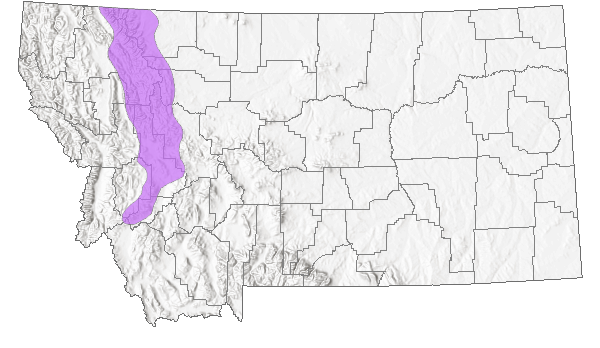
 Native
Native
Range Comments
Montana (Flathead, Lewis and Clark, Pondera, and Teton counties) and Alberta (Waterton Lakes National Park, Sofa Mountain).
Observations in Montana Natural Heritage Program Database
Number of Observations: 83
(Click on the following maps and charts to see full sized version)
Map Help and Descriptions
Relative Density
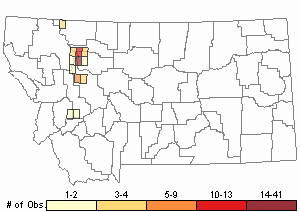
Recency
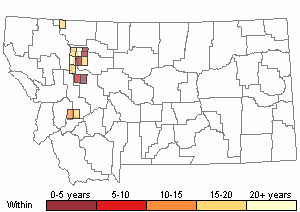
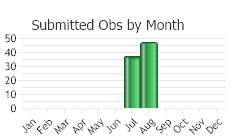
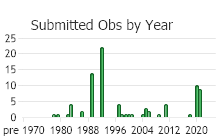
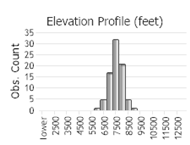 (Observations spanning multiple months or years are excluded from time charts)
(Observations spanning multiple months or years are excluded from time charts)
Habitat
Open, gravelly, calcareous soil and talus on ridgetops in the alpine and subalpine zones.
Ecological Systems Associated with this Species
- Commonly Associated with these Ecological Systems
Alpine Systems
Ecology
POLLINATORS The following animal species have been reported as pollinators of this plant species or its genus where their geographic ranges overlap:
Bombus bifarius,
Bombus centralis,
Bombus fervidus,
Bombus flavifrons,
Bombus huntii,
Bombus melanopygus,
Bombus mixtus,
Bombus rufocinctus,
Bombus occidentalis, and
Bombus insularis (Thorp et al. 1983, Wilson et al. 2010, Colla and Dumesh 2010, Koch et al. 2012).
Stewardship Responsibility
Threats or Limiting Factors
STATE THREAT SCORE REASON
Reported threats to Montana's populations of Lackschewitz' Fleabane are currently assigned as unknown (MTNHP Threat Assessment 2021). Populations along hiking trails are known to be at risk of some trampling by hikers, but related impacts to plants and populations are presumed to be negligible.
References
- Literature Cited AboveLegend:
 View Online Publication
View Online Publication Colla, S.R. and S. Dumesh. 2010. The bumble bees of southern Ontario: notes on natural history and distribution. Journal of the Entomological Society of Ontario 141:39-68.
Colla, S.R. and S. Dumesh. 2010. The bumble bees of southern Ontario: notes on natural history and distribution. Journal of the Entomological Society of Ontario 141:39-68. Koch, J., J. Strange, and P. Williams. 2012. Bumble bees of the western United States. Washington, DC: USDA Forest Service, Pollinator Partnership. 143 p.
Koch, J., J. Strange, and P. Williams. 2012. Bumble bees of the western United States. Washington, DC: USDA Forest Service, Pollinator Partnership. 143 p. MTNHP Threat Assessment. 2021. State Threat Score Assignment and Assessment of Reported Threats from 2006 to 2021 for State-listed Vascular Plants. Botany Program, Montana Natural Heritage Program, Helena, Montana.
MTNHP Threat Assessment. 2021. State Threat Score Assignment and Assessment of Reported Threats from 2006 to 2021 for State-listed Vascular Plants. Botany Program, Montana Natural Heritage Program, Helena, Montana. Thorp, R.W., D.S. Horning, and L.L. Dunning. 1983. Bumble bees and cuckoo bumble bees of California (Hymenoptera: Apidae). Bulletin of the California Insect Survey 23:1-79.
Thorp, R.W., D.S. Horning, and L.L. Dunning. 1983. Bumble bees and cuckoo bumble bees of California (Hymenoptera: Apidae). Bulletin of the California Insect Survey 23:1-79. Wilson, J.S., L.E. Wilson, L.D. Loftis, and T. Griswold. 2010. The montane bee fauna of north central Washington, USA, with floral associations. Western North American Naturalist 70(2): 198-207.
Wilson, J.S., L.E. Wilson, L.D. Loftis, and T. Griswold. 2010. The montane bee fauna of north central Washington, USA, with floral associations. Western North American Naturalist 70(2): 198-207.
- Additional ReferencesLegend:
 View Online Publication
View Online Publication
Do you know of a citation we're missing? Heidel, B.L. 1993. Report on the conservation status of Erigeron lackschewitzii, a candidate threatened species. Unpublished report to U.S. Fish and Wildlife Service. Montana Natural Heritage Program, Helena, MT. 57 pp.
Heidel, B.L. 1993. Report on the conservation status of Erigeron lackschewitzii, a candidate threatened species. Unpublished report to U.S. Fish and Wildlife Service. Montana Natural Heritage Program, Helena, MT. 57 pp. Kerstetter, T. 1994. Interim report on the taxonomy of Erigeron lackschewitzii. Unpublished report to the Montana Natural Heritage Program, Helena, MT. 16 pp.
Kerstetter, T. 1994. Interim report on the taxonomy of Erigeron lackschewitzii. Unpublished report to the Montana Natural Heritage Program, Helena, MT. 16 pp. Kerstetter, T.A. 1993. Preliminary report on taxonomy of Erigeron lackschewitzii. Unpublished report to U.S. Fish and Wildlife Service. Montana Natural Heritage Program, Helena, MT. 12 pp.
Kerstetter, T.A. 1993. Preliminary report on taxonomy of Erigeron lackschewitzii. Unpublished report to U.S. Fish and Wildlife Service. Montana Natural Heritage Program, Helena, MT. 12 pp. Kerstetter, T.A. 1994. Taxonomic investigation of Erigeron lackschewitzii. M.Sc. Thesis. Bozeman, MT: Montana State University. 90 p.
Kerstetter, T.A. 1994. Taxonomic investigation of Erigeron lackschewitzii. M.Sc. Thesis. Bozeman, MT: Montana State University. 90 p. Lesica, P., M.T. Lavin, and P.F. Stickney. 2012. Manual of Montana Vascular Plants. Fort Worth, TX: BRIT Press. viii + 771 p.
Lesica, P., M.T. Lavin, and P.F. Stickney. 2012. Manual of Montana Vascular Plants. Fort Worth, TX: BRIT Press. viii + 771 p. Lesica, P., M.T. Lavin, and P.F. Stickney. 2022. Manual of Montana Vascular Plants, Second Edition. Fort Worth, TX: BRIT Press. viii + 779 p.
Lesica, P., M.T. Lavin, and P.F. Stickney. 2022. Manual of Montana Vascular Plants, Second Edition. Fort Worth, TX: BRIT Press. viii + 779 p. Nesom, Guy L. 2004. Taxonomic Reevaluations in North American Erigeron (Asteraceae: Astereae). SIDA 21(1): 19–39.
Nesom, Guy L. 2004. Taxonomic Reevaluations in North American Erigeron (Asteraceae: Astereae). SIDA 21(1): 19–39. Nesom. GL and WA. Webe. 1983. A new woolly-headed, Monocephalous erigeron (Asteraceae) from Montana. Madrono 30:245-249
Nesom. GL and WA. Webe. 1983. A new woolly-headed, Monocephalous erigeron (Asteraceae) from Montana. Madrono 30:245-249
- Web Search Engines for Articles on "Lackschewitz' Fleabane"





